In this post we're going to cover an email marketing strategy eCommerce companies can use to instantly increase sales.
In fact to date our customers have generated $80,000,000+ collectively using this exact strategy. Below I'm going to lay out each campaign they use and
show you real life examples from eCommerce companies doing this right now.
But first, here's what we need to stop doing...
to
'Batch and Blast email' is a trend that we are advocating to come to an end in 2016.
If you're unsure of what a 'batch and blast' email is, it's an email such as a monthly newsletter that goes out to all of your customers regardless of
buying or browsing habits, how many touch-points they've had with your store or any other segmenting divider you can think of to segment your customers.
After sending millions of behaviorally triggered email campaigns on behalf of our clients and studying the email programs of the world's top eCommerce companies - we're convinced that most
companies can be performing better.
If you're still sending unsegmented newsletter blasts to your entire list, then it's only a matter of time before your customers begin tuning you out and
your growth from email starts to slow down.
With the level of advanced email tools available to date, batch and blast emails should only be a small portion of the emails you are sending.
Email marketing today is all about sending well timed and relevant emails to the right people at the right time.
And in this post we're going to show you our recommended email marketing strategy for eCommerce companies who are looking to dramatically improve their ROI
from email marketing.
eCommerce Email Marketing Best Practices: Use Lifecycle Email...
What is lifecycle email and why is it important?
At any given time a customer is at a different point in their relationship with your product or brand. Think of the customer's lifecycle as a journey. Lifecycle marketing happens when retailers send customers emails that are relevant to what stage
they are at in the customer lifecycle.
Rather than sending bulk generic emails to any and all customers, lifecycle emails are targeted to specific customers at crucial points in their journey as
you can see displayed in the image below.

Now I'm going to cover 6 lifecycle email campaigns we recommend you start sending first in order to increase your sales from new, existing, declining and
lapsed customers.
1. Abandoned Cart Emails
If we could only choose one lifecycle email campaign to setup and run forever, it would be the abandoned cart campaign.
Most of our customers see a 10% lift in yearly revenue from this one campaign.
Customers are giving you an very strong signal of purchase intent when they visit the checkout page on your site. Think of cart abandonment emails as your
second chance to continue the conversation with this incredibly important group of potential customers that got so close to buying something from you.
By building a quality abandoned cart email program, one of three things will happen when you follow up with them with email:
1.
You'll win the order 10-15% of the time.
2.
You'll find out why the customer didn't buy and use this qualitative information to proactively improve your checkout process.
3.
You'll create a great customer service moment and leave an everlasting impression on the customer.
Here's how we recommend you setup your abandoned cart email campaign to maximize revenue
Approach your campaign with a customer service focus and send a customer service email within 30 minutes of the cart being abandoned
Use your first abandoned cart email to create a memorable customer service moment. Encourage customers to pick up the phone and call you or prompt them to
reply to the email with their questions.
Your job is to provide amazing customer service and find out why someone abandoned. To uncover these insights:
- Include your toll free number prominently within the email
- Write your copy using a helpful customer service tone
- Send from a live, monitored inbox and ask your customers for feedback
- Send from a real person's name and include a photograph of a real person in the footer of the email to make customers feel more
comfortable about providing you this feedback
Asking simple questions like, Was there a problem? or How can we help? will generate real, qualitative responses about what friction
points are causing customers to abandon in the first place. This is priceless information.
Here's a perfect example from Liftopia.com
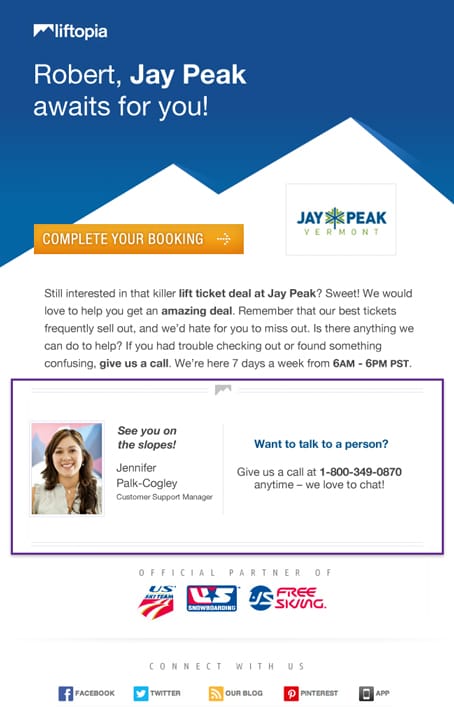
Assume your abandonment emails will be opened on a mobile device
Over 50% of the 5,000,000 monthly emails sent by Rejoiner are opened on a device that is different than the one the customer originally abandoned on. Think
about that for a second.
More than half the time, customers will consume your email on a different device than where the first touch occurred.
Therefore you must design & code responsive email templates so that they render well
on mobile devices
, as this is more than likely where customers will consume them. More importantly, regenerate cart sessions across devices so customers have a seamless
shopping experience from device to device.
Segment Abandoned Carts for Better Targeting & Filtering
Segmentation
enables you to identify your most valuable customers. For example, you may want to develop a special free shipping offer or a big percentage off discount
for your high value / high margin products because there's more room to provide a discount here versus a $25 product with a much smaller margin.
Send a Second and Third Email to Customers Who Haven't Purchased
If your first email wasn't successful at converting the customer or eliciting a response, try sending a second and third email. Sending 3 emails 30
minutes, 24 hours and 3 days post abandon is our recommended starting point for retailers.
Here's a campaign from a Rejoiner customer to give you an idea of the % of revenue each email can generate:
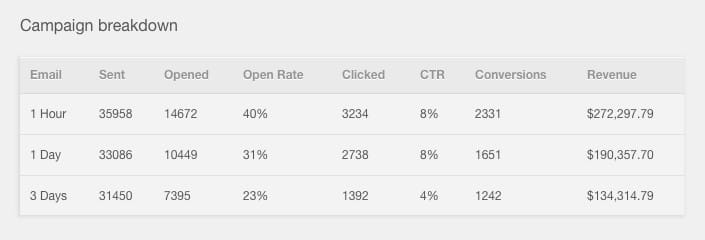
Use Recommendations to Increase Click-Through Rates and Average Order Value
If someone receives an abandoned cart email but no longer wants the product, you can serve them images of other top selling items in that category that
they make like instead which helps increase click-through rate back to your store.
Or you can serve them with images of other products that are frequently purchased together (along with their abandoned cart item) which will allow them to
add more products to their previous cart and increase average order value in the process.
Adopt a Mentality of Ongoing Optimization To Generate More Revenue
Our team can increase a cart abandonment campaigns' recovered revenue up to 100% with consistent testing over 6 months.
Think about your abandoned cart email program as a constant work in progress. Split testing is the most powerful tool at your disposal to improve
engagement metrics like open rate, click-through rate and conversion. There is no silver bullet to magically drive conversion upwards overnight, but
consistent testing can string together many small wins and a big increase in revenue generated.
Here are a few things we like to test:
- Email timing (30-60 minutes, 1-3 days)
- Subject line (Can we help you?)
- Copy length and tonePersonalization
- Offer (free shipping vs % off)
We've created a helpful guide
that outlines 22 different ways you can test your abandoned cart email campaigns to grow revenue.
2. Win Back Email Campaign
Right behind the cart abandonment campaign we've found the win back campaign has the highest ROI opportunity.
We've written an in-depth article on why you should be sending win back email campaigns and how to make them convert by
measuring a metric known as 'purchase latency' (the time between purchases).
If we understand how long it takes customers to go from purchase 1 to 2, 2 to 3, 3 to 4, etc. then we know what "normal" and "abnormal" purchasing
behaviour looks like. When customers start showing signs of "abnormal" behavior, and have likely stopped buying from us, we then know when the best time
would be to send a win-back campaign to maximize revenue.
It's a lot easier to get a previous customer to buy from you again versus getting someone who's never heard of you before to make their first purchase.
Calculating The Perfect Time To Trigger A Win-Back Campaign
We like to use an internal tool we've built for eCommerce marketers that takes a customer purchase dataset and calculates average latency periods to
understand what "normal" behaviour looks like for their customer lifecycle. Here's an example
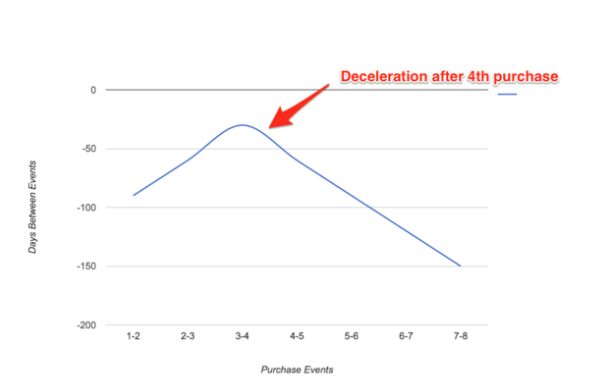

In the example above, deceleration starts after a customer has made their 4th purchase.
Say if this was your business and most customers made their 4th purchase within 90 days, anyone who doesn't make their 4th purchase by day 90 is showing
signs of "abnormal" behaviour, so day 91 is when you would trigger your win back campaign inside your email marketing software.
It's going to be different depending on your product and your customer lifecycle. It can vary a lot and that's why we like to measure purchase latency
first. (If you have any questions about this just ask in the comments below).
3. New Customer Welcome Series
One of our customers Mossy Oak Graphics uses a new customer
welcome series to tell the story of their brand. New customer welcome series emails should trigger immediately after a customer has made their first
purchase.
Here's how Mossy Oak's 3 part welcome series works (plus ideas on how you can create your very own new customer welcome series):
1st email
-
A personalized welcome with a strong brand statement begins by telling the company's history to establish credibility and trust. Links to social
media-Twitter, Youtube, Instagram - help to carry engagement over to other channels. More importantly, letting people know the story of your company makes
them feel a part of something bigger and better - rather than thanking them for simply buying a product.
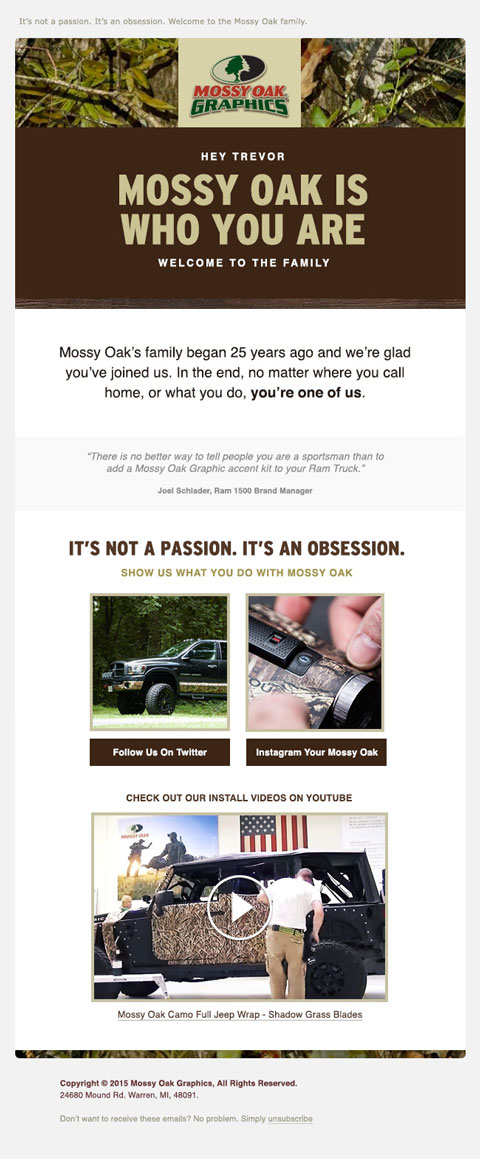
2nd email -
The goal of the second email in your welcome series is to have your customer learn more about you, and engage with the content you create on other mediums.
You can also ask them about their experience with shipping, etc. If you decide to do the latter, these "checks up" on the customer's new product are done
in a friendly, casual way. You want to make it so that your customer wants to give you feedback with a well placed CTA button. Testimonials with visuals
further solidify the brand's reputation. Links to information about your products keep the customer excited and engaged.
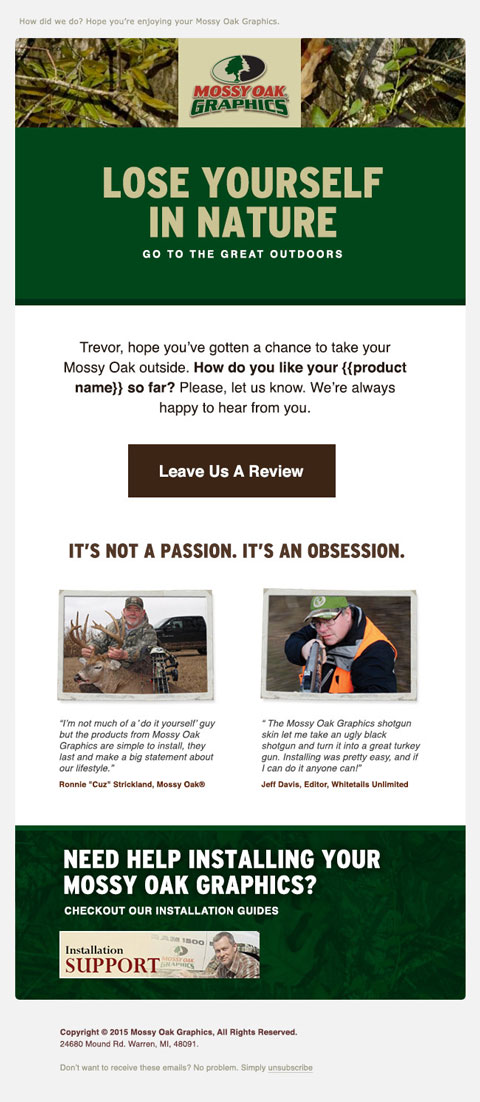
3rd email -
This is where a discount will be offered. In the example we're using, we have a 10% discount which gives the customer incentive to make that second
purchase. More importantly, Rejoiner has timed this email to match the frequency with which customers usually make their second purchase after becoming a
part of the Mossy Oak family.
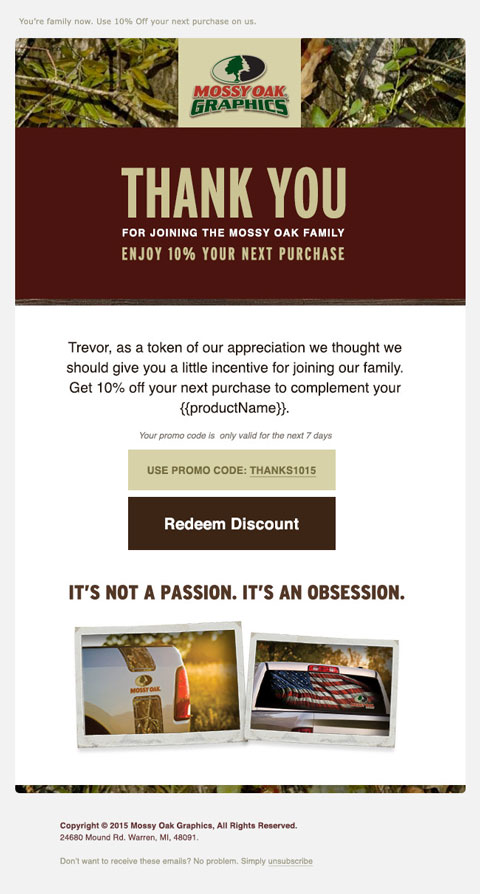
Giving a discount is key in getting your customers to make a second purchase and turning them into a repeat customer.
Note that you want to avoid placing the discount in the first email. This allows you to carefully craft your brand image and familiarize the customer with
all the best aspects of your company. They shouldn't expect an offer in every email. This is vital to cover the customer acquisition cost and move them up
the lifecycle curve towards becoming a loyal VIP.
4. New Subscriber Welcome Series
Welcome emails are hugely important for a number of reasons. The beginning of your email relationship with a possible customer is crucial in introducing
them to your brand and setting the stage for the all important first purchase.
Welcome emails have a 42% higher read rate than other types of
emails. With this type of visibility you are in the perfect position to introduce your products and spark engagement with a potential customer.
It's not enough to simply introduce your brand and warmly welcome a new friend. Remember the goal is to provoke that first purchase, so offer something to
increase your chances.
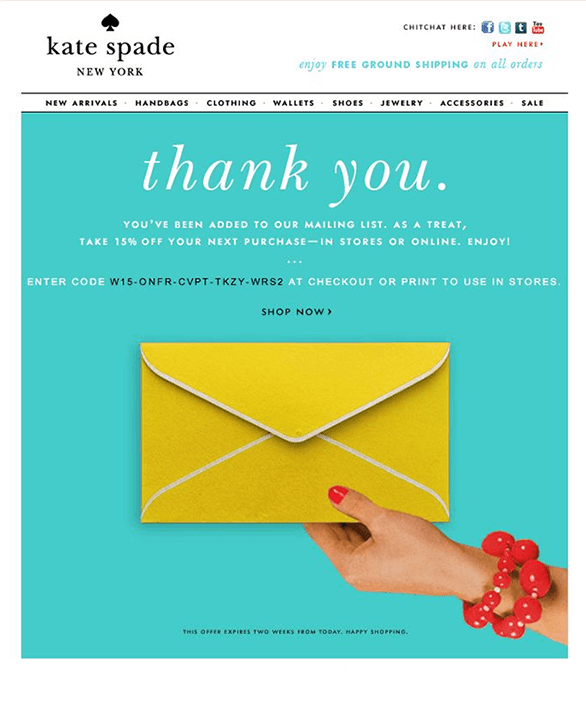
This new subscriber welcome email from Kate Spade is a great example of eye catching design and a clear call to action. The recipient is rewarded with a
"treat" of 15% off and free ground shipping. There is also urgency however as the offer expires in two weeks to encourage the subscriber to act now. This
email makes the subscriber feel welcomed, special and incentivized to make that all important first purchase.
5. VIP Campaign - Target your best customers and make them feel appreciated
The 80/20 rule shows that 20% of your customers generate 80% of your revenue and profits. And that's why retention of these VIP's should be a top priority.
Identify your VIP customers
The first thing you want to do is identify your VIPs. VIP status will be different for every business. For instance, you may want to target those who've
purchased from you in the last month and/or customers that have bought from you 3 or more times. You may need to adjust this formula up or down depending
on the products you're selling but it's a good place to start. Whatever you do, you need to
segment them in order to send the most engaging emails
.
Below we have some examples from
J. Crew
of effective VIP emails they have used.
The first email is a personal note from the Head of Design at J. Crew, acknowledging the customer as one of their best customers. He then tells them a
short story about a special new product that is ready (with the tanning process on the leather taking 6 months...) and that they can 'check them out
here'. A subtle CTA at the end of the letter (avoiding the hard sell) makes you want to click and learn more, especially if you've already bought a
number of their products.

The second email opts for simplicity over visuals with a bold offer (20% off and free shipping) taking center stage. This email simply acknowledges that
the customer is 'one of their best' and gives them a great offer.
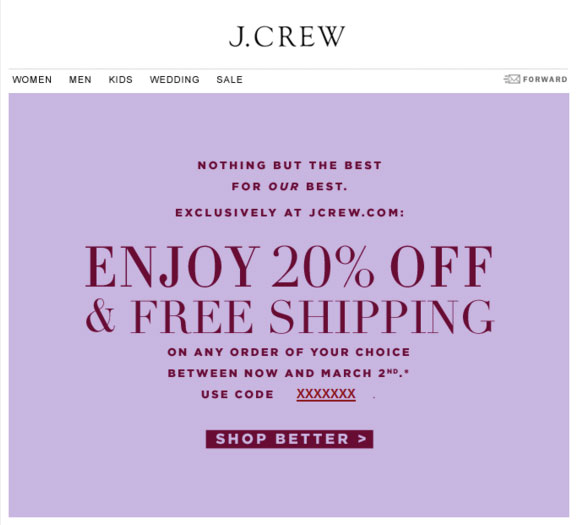
6. Replenishment
These emails from,
Rockin' Wellness
, are examples of effective replenishment campaigns.
If the product you are selling is consumable in any way, shape or form, you want to make sure that you aren't leaving any potential revenue untapped.
Replenishment email campaigns provide a great source of recurring revenue if triggered at the right moment.
Consumables-products that are used, consumed, etc-- need to be replenished at some point. Think food, household products, pet products, grooming, health
and beauty products. The list goes on.
Replenishment emails are strategic because you already have valuable information about the customer. You know what they need and when they are going to
need it.
Here, Rockin' Wellness knows that this customer bought a one month supply of their supplement. They use this information in their email to restate the
product's benefits and remind them that they might be running low. This should create the need for another purchase.
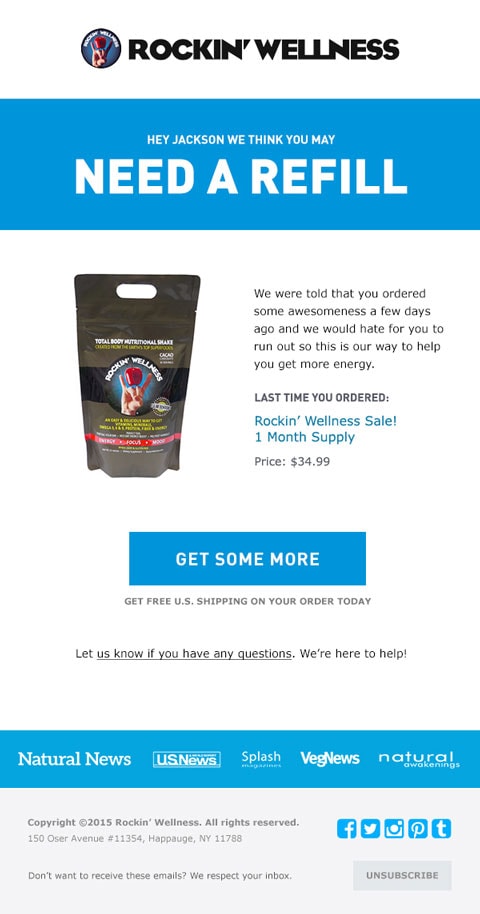
Rockin' Wellness uses 30 and 60 day replenishments. If the product is meant to last 30 days, a replenishment email is sent out 20 days post-purchase. If
it's a 60 day supply, an email is sent out on day 50. This is to make sure they get a new supply before they run out.

These campaigns work best with products that have very predictable usage patterns. Identify the consumable used and build campaigns that target the exact
moment the product is scheduled to run out.
Lessons from this post…
Here's the 80/20 digest of this post:
1. Reduce the amount of 'batch and blast' emails (newsletters) going out to your entire customer list.
2. Start understanding the customer lifecycle curve for your business so you can send the right emails to the right people at the right time.
3. If you are only going to do one thing after read this post, it should be setting up a 3 step cart abandonment email campaign as we've outlined above.
4. Start A/B testing your cart abandonment campaign to increase revenue generated (we generally find you can increase performance by 100%)
5. Implement campaigns 2-6, one at a time and measure results.
6. Enjoy more sales from email.
If you found this post useful, let us know on Twitter - @rejoinerapp.
If you'd like to learn more about improving your ROI from email then head over to the Rejoiner resources section.